Key Takeaways:
- Ghost kitchens (also called cloud or virtual kitchens) are delivery-only food production facilities with no dine-in customers
- There were an estimate 1,500 ghost kitchens in the U.S. in 2024, each often operating multiple virtual brands out of one facility
- Unlike traditional restaurants, ghost kitchens skip the front-of-house entirely, relying almost entirely on kitchen staff and delivery coordination
- This lean setup lowers rent and labor costs, but it also creates new staffing headaches
For operators and jobseekers alike, hiring for a ghost kitchen can feel more complex than staffing a normal restaurant. Ghost kitchens require fewer staff (no waiters or hosts), yet the workers they do employ must juggle many roles. Owners often turn over kitchen roles or bring in part-time help as menus rotate.
Meanwhile, competition for talented Cooks and managers is fierce after the pandemic-driven industry labor shortage. In practice, ghost kitchens still need Chefs, Line Cooks, a Kitchen Manager, plus order-packers and couriers.
The challenge is finding workers who can thrive in a mostly digital, takeaway-centric environment.
OysterLink: A Dedicated Platform for Kitchen Careers
OysterLink is the fastest-growing U.S. job platform tailored to restaurants and hospitality. It features delivery-only and ghost kitchen roles alongside traditional restaurant jobs. Unlike general job boards, OysterLink is built specifically for the foodservice industry, so employers know applicants have relevant experience.
For ghost kitchen operators and chains, OysterLink offers super easy job postings for all roles – from kitchen staff to management. Recruiters can reach “over 400,000 professionals actively looking for hospitality work”. Employers benefit from industry-specific filters and the ability to target listings to major markets or even remote/post-only roles.
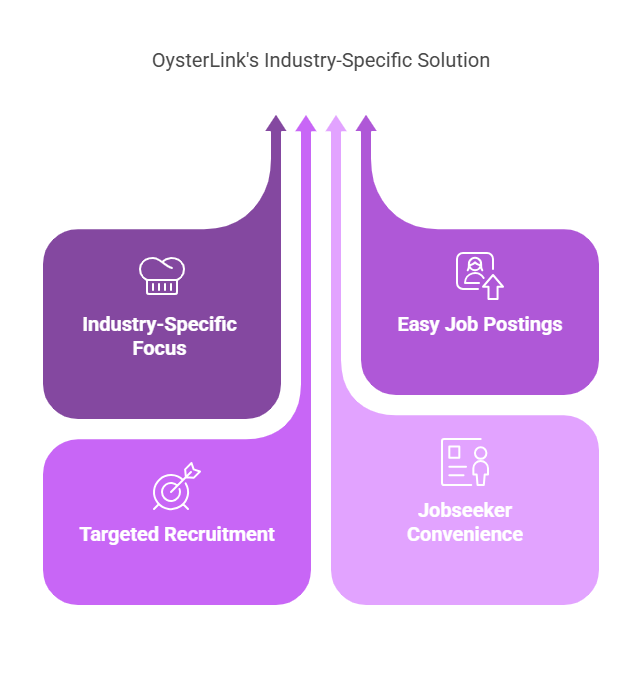
Jobseekers also find OysterLink convenient: we list thousands of positions across the U.S., sortable by city or role type. In short, OysterLink streamlines the connection between virtual kitchen operators who need staff and workers who specialize in takeout/delivery foodservice.
Recruitment and Retention Innovations
To attract the scarce talent they need, many ghost kitchen operators are getting creative. Some offer sign-on and retention bonuses, especially for critical roles like Head Cook or Kitchen Manager.
For instance, a budding ghost-brand pizza outfit might promise a $200 bonus after 90 days on the job. Others include perks like free meals during shifts or guaranteed hours.
Training also goes virtual: new hires often complete interactive video modules at home before stepping into the kitchen. Specialized e-learning platforms let staff study a kitchen’s workflows and recipes on their own time. This virtual onboarding saves on in-person training time and ensures every shift starts with staff who have reviewed the material.
Continuous upskilling is encouraged; for example, employees can earn badges or pay bumps by completing short online courses in food safety or multi-kitchen operations. These programs not only boost skills but also help create a sense of progression in a highly transient workforce.
On the tech side, some operators use AI and analytics to improve retention. Advanced systems can predict busy hours and adjust schedules to give rest during lulls. This kind of predictive scheduling means workers face fewer last-minute shift surprises.
Additionally, AI-driven chatbots or text services can handle routine HR questions and allow staff to swap shifts among themselves, improving flexibility. By leveraging technology for scheduling and communication, ghost kitchens make the work environment more adaptable – a plus for younger or tech-oriented hires.
Unique Staffing Challenges
- Limited In-Person Training: Without a storefront or dining room, new hires often start with minimal face-to-face instruction. Ghost kitchens turn to digital training and e-learning tools so employees can adapt quickly to rotating menus and new processes. This remote style can make it harder to build cooking skills and brand standards through traditional shadowing.
- High Turnover and Retention: The restaurant industry already sees turnover around 75%. Ghost kitchens, operating with “on-demand” staff, find it difficult to attract and keep committed workers. Workers can burn out packing and fulfilling orders under pressure, or jump ship to better-known brands. Many ghost-kitchen operators now offer sign-on bonuses or referral incentives to hire and reward loyal staff.
- Isolation and Culture Gaps: Staff often work alone or in small teams, without a dining room buzz or regular face time with coworkers. Experts note that it’s challenging to “build a consistent brand culture” in this on-demand model. There’s no “service pulse” or customer feedback in real time, making it harder to motivate teams. Maintaining morale and cohesion takes effort, sometimes relying on virtual check-ins, team chats, or creative perks.
- Tech-Centric Roles: Ghost kitchen employees must be tech-savvy. Everything from order intake to inventory is managed on screens and apps. This “Food 2.0” approach brings a “more tech-savvy back of the house”. Staff juggle multiple tablet orders and delivery apps, requiring fluency with POS systems and often even simple data entry or AI tools. The need for digital skills limits hiring to candidates comfortable with technology, which can narrow the labor pool.
Each of these factors adds friction to hiring. The result is a kitchen environment that relies on cross-trained generalists: Cooks who can pack orders, and packers who can cook. Workers must also collaborate closely despite often working asynchronous shifts.
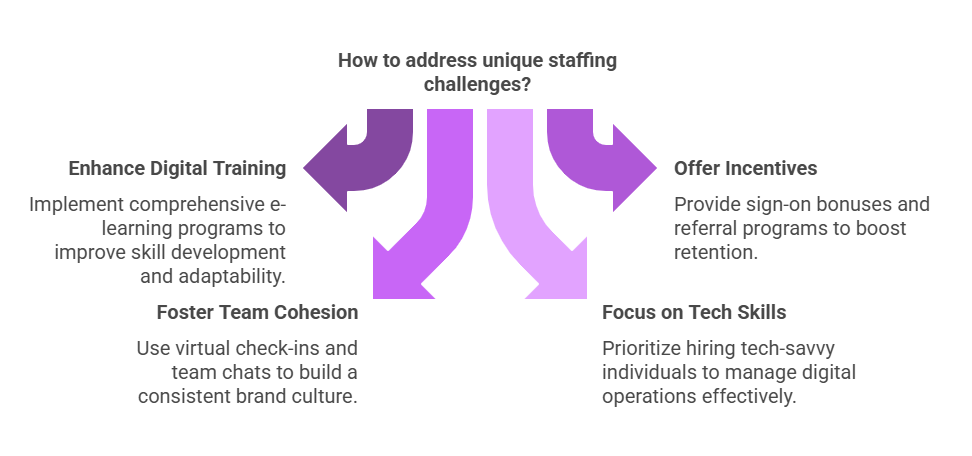
Implications for Teamwork and Service Quality
Without a dining room, ghost kitchen teams miss out on the usual camaraderie of restaurant floors. A chalkboard emblazoned with “TEAMWORK” and a handshake is a rare sight in delivery-only facilities. In practice, crews may see each other only via order screens or brief hand-offs, so strong communication is essential.
When workers do come together (for example, during a shift change or inventory prep), building trust quickly is critical. If one Cook “drops the ball” on an order, there’s no Waiter to catch the mistake – the kitchen itself is the service.
The lack of walk-in customers also means feedback loops are delayed; customer complaints often come indirectly through apps. This can hurt consistent quality. As such, ghost kitchen operators have little control over the quality of last-mile deliveries, which affects their reputation.
In turn, kitchen teams must self-police food quality and timing more rigorously than in a traditional setting. Some operators schedule brief daily huddles or use cameras and checklists to keep quality high.
Despite the isolation, many ghost kitchen owners try to foster team spirit. Quick huddles at shift start, branded sweatshirts, or profit-sharing can help create a sense of belonging.
Some virtual kitchens now provide ongoing support via online communities and manager check-ins to keep staff engaged. When workers feel connected to the brand story, they are likelier to stay on the job.
Cross-Training, Scheduling, and Multi-Brand Operations
Operating a ghost kitchen isn’t just about making food—it’s about orchestrating a highly adaptable, tech-enabled workforce that can shift gears quickly and efficiently. As delivery-first brands multiply, labor agility is no longer optional; it’s the foundation of operational success.
- Cross-Functional Skills: Ghost kitchen staff often wear many hats. A Cook might also pack meals, or answer a hotline if a customer calls, simply because the team is small. This cross-functional training is expected: one employee might prep, plate and package one order. Hiring managers thus look for flexible candidates who can handle a fast-paced, changing menu and assist wherever needed. Training programs now emphasize multi-skill learning to fill these gaps.
- Flexible Scheduling: Delivery demand can be very unpredictable – a heat wave or big game day can spike orders. To match labor to demand, ghost kitchens use very flexible scheduling. Managers often post shifts week-by-week, and some staff work on call. Modern scheduling apps are a boon: one industry staffing provider notes that real-time scheduling tools can lower labor costs and reduce mistakes. By tracking hours through an app, ghost kitchens easily reassign staff at a moment’s notice or close unneeded shifts. During the pandemic, many restaurants (including virtual ones) even offered “open scheduling” where employees pick the shifts they want from a pool of delivery-heavy hours.
- Multi-Brand Management: In many facilities, a single kitchen churns out food for several brands. For example, a fast-casual chain might run separate burger, wings and salad virtual brands from the same oven. This means one Cook could be toggling between menus in the same hour. Efficiently managing multiple recipes, assembly stations and packaging requirements creates extra staffing demands. Workers must be aware of shifting priorities as different brand orders come in, which is a real challenge without the context of a single restaurant concept. Hiring such multi-taskers can be tough.
- Impact of Third-Party Delivery: Ghost kitchens rely heavily on DoorDash, Uber Eats, Grubhub and similar services. This changes staffing needs significantly. For one, it eliminates the need for in-house drivers – most kitchens simply place orders with couriers. But it also means kitchens must process incoming orders from many platforms simultaneously. Managers often station a staffer or two at the screens to confirm rushes and troubleshoot app glitches. Because delivery fees and promo competition can vary by platform, some ghost kitchens run simultaneous promotions that spike certain apps – requiring quick schedule adjustments. In short, third-party delivery drives when and how many people are needed, leading many operators to adopt just-in-time hiring and shift-swapping. (Some ghost concepts have even experimented with automated staffing: for instance, AI tools that forecast order volume to suggest staffing levels.)
Final Thoughts
In the tight labor market of 2025, ghost kitchen staffing will remain a moving target. By understanding these unique labor dynamics — from training hurdles to tech requirements — operators and jobseekers can better navigate this space.
With specialized platforms like OysterLink helping match talent to the delivery-focused kitchen, virtual brands stand a better chance of building strong, cohesive teams.
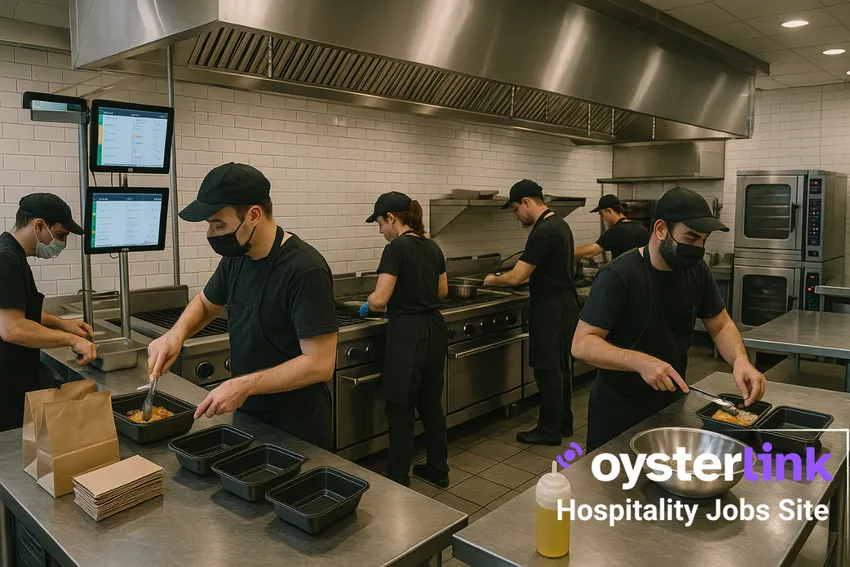
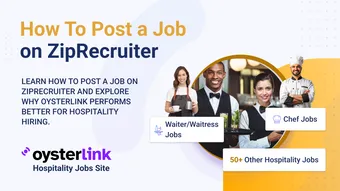
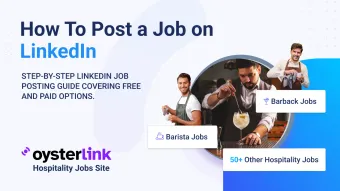
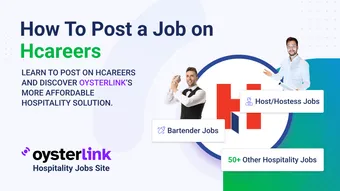



Loading comments...